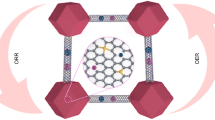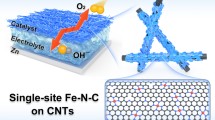Abstract
The transition metal compound catalysts have been taken a great part in renewable energy conversion and storage systems. Herein, we report the uniform CoFe2O4 nanoparticles with abundant oxygen vacancies and specific active surface exposed through the simple hydrothermal reaction for improving the electrocatalytic performance and stability. They show good electrocatalytic performance for hydrogen evolution reaction in 0.5 M H2SO4 with an onset potential of 20 mV, the overpotential of 45 mV (at j = 10 mA/cm2), and remarkable long-term stability more than 100 h at different current densities and better oxygen reduction reaction activity with lower overpotential in 0.1 M KOH. Moreover, the home-made primary Zn-air batteries, using CoFe2O4 nanoparticles as an air-cathode display the high open-circuit voltage of 1.47 V and the maximum power density of 142 mW/cm2. The two-series-connected batteries fabricated by CoFe2O4 nanoparticles can support a light-emitting diode to work for more than 48 h.




Similar content being viewed by others
References
A.S. Aricò, P. Bruce, B. Scrosati, J-M. Tarascon, and W.V. Schalkwijk: Nanostructured materials for advanced energy conversion and storage devices. Nat. Mater. 4, 366 (2005).
S.S. Shinde, C-H. Lee, A. Sami, D-H. Kim, S-U. Lee, and J-H. Lee: Scalable 3-D carbon nitride sponge as an efficient metal-free bifunctional oxygen electrocatalyst for rechargeable Zn–air batteries. ACS Nano 11, 347 (2017).
J. Zhang, Z. Zhao, Z. Xia, and L. Dai: A metal-free bifunctional electrocatalyst for oxygen reduction and oxygen evolution reactions. Nat. Nanotechnol. 10, 444 (2015).
S. Zhao, H. Yin, L. Du, L. He, K. Zhao, L. Chang, G. Yin, H. Zhao, S. Liu, and Z. Tang: Carbonized nanoscale metal-organic frameworks as high performance electrocatalyst for oxygen reduction reaction. ACS Nano 8, 12660 (2014).
Z-Q. Liu, H. Cheng, N. Li, T.Y. Ma, and Y-Z. Su: ZnCo2O4 quantum dots anchored on nitrogen-doped carbon nanotubes as reversible oxygen reduction/evolution electrocatalysts. Adv. Mater. 28, 3777 (2016).
K. Gong, F. Du, Z. Xia, M. Durstock, and L. Dai: Nitrogen-doped carbon nanotube arrays with high electrocatalytic activity for oxygen reduction. Science 323, 760 (2009).
L. Duan, F. Bozoglian, S. Mandal, B. Stewart, T. Privalov, A. Llobet, and L. Sun: A molecular ruthenium catalyst with water-oxidation activity comparable to that of photosystem II. Nat. Chem. 4, 418 (2012).
C. Cui, L. Gan, M. Heggen, S. Rudi, and P. Strasser: Compositional segregation in shaped Pt alloy nanoparticles and their structural behavior during electrocatalysis. Nat. Mater. 12, 765 (2013).
C. Zhang, S. Hwang, A. Trout, and Z. Peng: Solid-state chemistry-enabled scalable production of octahedral Pt–Ni alloy electrocatalyst for oxygen reduction reaction. J. Am. Chem. Soc. 136, 7805 (2014).
L. Dai, Y. Xue, L. Qu, H. Choi, and J. Baek: Metal-free catalysts for oxygen reduction reaction. Chem. Rev. 115, 4823 (2015).
K. Fominykh, P. Chernev, I. Zaharieva, J. Sicklinger, G. Stefanic, M. Döblinger, A. Müller, A. Pokharel, S. Böcklein, C. Scheu, T. Bein, and D. Fattakhova-Rohlfing: Iron-doped nickel oxide nanocrystals as highly efficient electrocatalysts for alkaline water splitting. ACS Nano 9, 5180 (2015).
Q. Liu, Y. Wang, L. Dai, and J. Yao: Scalable fabrication of nanoporous carbon fiber films as bifunctional catalytic electrodes for flexible Zn-air batteries. Adv. Mater. 28, 3000 (2016).
B. Liu, C. Wu, J. Miao, and P. Yang: All inorganic semiconductor nanowire mesh for direct solar water splitting. ACS Nano 8, 11739 (2014).
J. Mefford, X. Rong, A. Abakumov, W. Hardin, S. Dai, A. Kolpak, K.P. Johnston, and J. Stevenson: Water electrolysis on La1−xSrxCoO3−δ perovskite electrocatalysts. Nat. Commun. 7, 11053 (2016).
P. Hiralal, S. Imaizumi, H. Unalan, H. Matsumoto, M. Minagawa, M. Rouvala, A. Tanioka, and G. Amaratunga: Nanomaterial-enhanced all-solid flexible zinc-carbon batteries. ACS Nano 4, 2730 (2009).
F. Cao, M. Zhao, Y. Yu, B. Chen, Y. Huang, J. Yang, X. Cao, Q. Lu, X. Zhang, Z. Zhang, C. Tan, and H. Zhang: Synthesis of two-dimensional CoS1.097/nitrogen-doped carbon nanocomposites using metal-organic framework nanosheets as precursors for supercapacitor application. J. Am. Chem. Soc. 138, 6924 (2016).
Y. Zhu, T. Ma, M. Jaroniec, and S. Qiao: Self-templating synthesis of hollow Co3O4 microtube arrays for highly efficient water electrolysis. Angew. Chem., Int. Ed. 56, 1324 (2017).
K. Qu, Y. Zheng, S. Dai, and S. Qiao: Graphene oxide-polydopamine derived N,S-codoped carbon nanosheets as superior bifunctional electrocatalysts for oxygen reduction and evolution. Nano Energy 19, 373 (2016).
T. Ling, D. Yan, Y. Jiao, H. Wang, Y. Zheng, X. Zheng, J. Mao, X. Du, Z. Hu, M. Jaroniec, and S. Qiao: Engineering surface atomic structure of single-crystal cobalt(II) oxide nanorods for superior electrocatalysis. Nat. Commun. 7, 12876 (2016).
T. Ma, J. Cao, M. Jaroniec, and S. Qiao: Interacting carbon nitride and titanium carbide nanosheets for high-performance oxygen evolution. Angew. Chem., Int. Ed. 55, 1138 (2016).
S. Chen, J. Duan, P. Bian, Y. Tang, R. Zheng, and S. Qiao: Three-dimensional smart catalyst electrode for oxygen evolution reaction. Adv. Energy Mater. 5, 1500936 (2015).
J. Duan, S. Chen, M. Jaroniec, and S. Qiao: Heteroatom-doped graphene-based materials for energy-relevant electrocatalytic processes. ACS Catal. 5, 5207 (2015).
H. Shi and G. Zhao: Water oxidation on spinel NiCo2O4 nanoneedles anode: Microstructures, specific surface character, and the enhanced electrocatalytic performance. J. Phys. Chem. C 118, 25939 (2014).
X. Gao, H. Zhang, Q. Li, X. Yu, Z. Hong, X. Zhang, C. Liang, and Z. Lin: Hierarchical NiCo2O4 hollow microcuboids as bifunctional electrocatalysts for overall water-splitting. Angew. Chem., Int. Ed. 55, 6290 (2016).
C. Xia, Q. Jiang, C. Zhao, M. Hedhili, and H. Alshareef: Selenide-based electrocatalysts and scaffolds for water oxidation applications. Adv. Mater. 28, 77 (2016).
V. Augustyn, P. Simon, and B. Dunn: Pseudocapacitive oxide materials for high-rate electrochemical energy storage. Energy Environ. Sci. 7, 1597 (2014).
R. Wang, J. Lang, Y. Liu, Z. Lin, and X. Yan: Ultra-small, size-controlled Ni(OH)2 nanoparticles: Elucidating the relationship between particle size and electrochemical performance for advanced energy storage devices. NPG Asia Mater. 7, e183 (2015).
Z. Yu, L. Tetard, L. Zhai, and J. Thomas: Supercapacitor electrode materials: Nanostructures from 0 to 3 dimensions. Energy Environ. Sci. 8, 702 (2015).
Y. Zhao, K. Kamiya, K. Hashimoto, and S. Nakanishi: In situ CO2-emission assisted synthesis of molybdenum carbonitride nanomaterial as hydrogen evolution electrocatalyst. J. Am. Chem. Soc. 137, 110 (2015).
J. Yin, Q. Fan, Y. Li, F. Cheng, P. Zhou, P. Xi, and S. Sun: Ni–C–N nanosheets as catalyst for hydrogen evolution reaction. J. Am. Chem. Soc. 138, 14546 (2016).
T. Wang, Y. Guo, Z. Zhou, X. Chang, J. Zheng, and X. Li: Ni–Mo nanocatalysts on N-doped graphite nanotubes for highly efficient electrochemical hydrogen evolution in acid. ACS Nano 10, 10397 (2016).
Y. Zhong, X. Xia, F. Shi, J. Zhan, J. Tu, and H. Fan: Transition metal carbides and nitrides in energy storage and conversion. Adv. Sci. 3, 1500286 (2016).
Y. Zhang, B. Ouyang, J. Xu, S. Chen, R. Rawat, and H. Fan: 3D porous hierarchical nickel-molybdenum nitrides synthesized by RF plasma as highly active and stable hydrogen-evolution-reaction electrocatalysts. Adv. Energy Mater. 6, 1600221 (2016).
L. Huang, D. Chen, Y. Ding, S. Feng, Z. Wang, and M. Liu: Nickel–cobalt hydroxide nanosheets coated on NiCo2O4 nanowires grown on carbon fiber paper for high-performance pseudocapacitors. Nano Lett. 13, 3135 (2013).
J. Yin, P. Zhou, L. An, L. Huang, C. Shao, J. Wang, H. Liu, and P. Xi: Self-supported nanoporous NiCo2O4 nanowires with cobalt-nickel layered oxide nanosheets for overall water splitting. Nanoscale 8, 1390 (2016).
L. An, L. Huang, P. Zhou, J. Yin, H. Liu, and P. Xi: Self-standing high-performance hydrogen evolution electrode with nanostructured NiCo2O4/CuS heterostructures. Adv. Funct. Mater. 25, 6814 (2015).
K. Xu, P. Chen, X. Li, Y. Tong, H. Ding, X. Wu, W. Chu, Z. Peng, C. Wu, and Y. Xie: Metallic nickel nitride nanosheets realizing enhanced electrochemical water oxidation. J. Am. Chem. Soc. 137, 4119 (2015).
D. Bediako, B. Lassalle-Kaiser, Y. Surendranath, J. Yano, V. Yachandra, and D. Nocera: Structure-activity correlations in a nickel–borate oxygen evolution catalyst. J. Am. Chem. Soc. 134, 6801 (2012).
J. Kibsgaard, Z. Chen, B. Reinecke, and T. Jaramillo: Engineering the surface structure of MoS2 to preferentially expose active edge sites for electrocatalysis. Nat. Mater. 11, 963 (2012).
K. Nam, S. Bak, E. Hu, X. Yu, Y. Zhou, X. Wang, L. Wu, Y. Zhu, K. Chung, and X. Yang: Combining in situ synchrotron X-ray diffraction and absorption techniques with transmission electron microscopy to study the origin of thermal instability in overcharged cathode materials for lithium-ion batteries. Adv. Funct. Mater. 23, 1047 (2013).
J. Zhang, L. Qu, G. Shi, J. Liu, J. Chen, and L. Dai: N,P-codoped carbon networks as efficient metal-free bifunctional catalysts for oxygen reduction and hydrogen evolution reactions. Angew. Chem., Int. Ed. 55, 2230 (2016).
H. Jin, J. Wang, D. Su, Z. Wei, Z. Pang, and Y. Wang: In situ cobalt–cobalt oxide/N-doped carbon hybrids as superior bifunctional electrocatalysts for hydrogen and oxygen evolution. J. Am. Chem. Soc. 137, 2688 (2015).
H. Wang, S. Zhuo, Y. Liang, X. Han, and B. Zhang: General self-template synthesis of transition-metal oxide and chalcogenide mesoporous nanotubes with enhanced electrochemical performances. Angew. Chem., Int. Ed. 55, 9055 (2016).
Y. Zhang, B. Ouyang, J. Xu, G. Jia, S. Chen, R. Rawat, and H. Fan: Rapid synthesis of cobalt nitride nanowires: Highly efficient and low-cost catalysts for oxygen evolution. Angew. Chem., Int. Ed. 55, 8670 (2016).
Y. Sharma, N. Sharma, G. Rao, and B. Chowdari: Studies on spinel cobaltites, FeCo2O4 and MgCo2O4 as anodes for Li-ion batteries. Solid State Ionics 179, 587 (2008).
T. Ma, S. Dai, M. Jaroniec, and S. Qiao: Metal-organic framework derived hybrid Co3O4-carbon porous nanowire arrays as reversible oxygen evolution electrodes. J. Am. Chem. Soc. 136, 13925 (2014).
C. McCrory, S. Jung, J. Peters, and T. Jaramillo: Benchmarking heterogeneous electrocatalysts for the oxygen evolution reaction. J. Am. Chem. Soc. 135, 16977 (2013).
P. Chen, K. Xu, Z. Fang, Y. Tong, J. Wu, X. Lu, X. Peng, H. Ding, C. Wu, and Y. Xie: Metallic Co4N porous nanowire arrays activated by surface oxidation as electrocatalysts for the oxygen evolution reaction. Angew. Chem., Int. Ed. 54, 14710 (2015).
M. Gao, X. Cao, Q. Gao, Y. Xu, Y. Zheng, J. Jiang, and S. Yu: Nitrogen-doped graphene supported CoSe2 nanobelt composite catalyst for efficient water oxidation. ACS Nano 8, 3970 (2014).
M. Gao, W. Sheng, Z. Zhuang, Q. Fang, S. Gu, J. Jiang, and Y. Yan: Efficient water oxidation using nanostructured α-nickel-hydroxide as an electrocatalyst. J. Am. Chem. Soc. 136, 7077 (2014).
M. Gong, Y. Li, H. Wang, Y. Liang, J. Wu, J. Zhou, J. Wang, T. Regier, F. Wei, and H. Dai: An advanced Ni–Fe layered double hydroxide electrocatalyst for water oxidation. J. Am. Chem. Soc. 135, 8452 (2013).
J. Bao, X. Zhang, B. Fan, J. Zhang, M. Zhou, W. Yang, X. Hu, H. Wang, B. Pan, and Y. Xie: Ultrathin spinel-structured nanosheets rich in oxygen deficiencies for enhanced electrocatalytic water oxidation. Angew. Chem., Int. Ed. 54, 7399 (2015).
F. Lei, Y. Sun, K. Liu, S. Gao, L. Liang, B. Pan, and Y. Xie: Oxygen vacancies confined in ultrathin indium oxide porous sheets for promoted visible-light water splitting. J. Am. Chem. Soc. 136, 6826 (2014).
G. Nam, J. Park, M. Choi, P. Oh, S. Park, M. Kim, N. Park, J. Cho, and J. Lee: Carbon-coated core–shell Fe–Cu nanoparticles as highly active and durable electrocatalysts for a Zn–air battery. ACS Nano 9, 6493 (2015).
F. Meng, H. Zhong, D. Bao, J. Yan, and X. Zhang: In situ coupling of strung Co4N and intertwined N–C fibers toward free-standing bifunctional cathode for robust, efficient, and flexible Zn–air batteries. J. Am. Chem. Soc. 138, 10226 (2016).
J. Park, M. Park, G. Nam, J. Lee, and J. Cho: All-solid-state cable-type flexible zinc–air battery. Adv. Mater. 27, 1396 (2015).
ACKNOWLEDGMENTS
The authors acknowledge the support from the National Natural Science Foundation of China (No. 21571089) and the Fundamental Research Funds for the Central Universities (lzujbky-2016-k02, lzujbky-2016-k09, lzujbky-2016-38).
Author information
Authors and Affiliations
Corresponding author
Rights and permissions
About this article
Cite this article
Yin, J., Shen, L., Li, Y. et al. CoFe2O4 nanoparticles as efficient bifunctional catalysts applied in Zn-air battery. Journal of Materials Research 33, 590–600 (2018). https://doi.org/10.1557/jmr.2017.404
Received:
Accepted:
Published:
Issue Date:
DOI: https://doi.org/10.1557/jmr.2017.404




